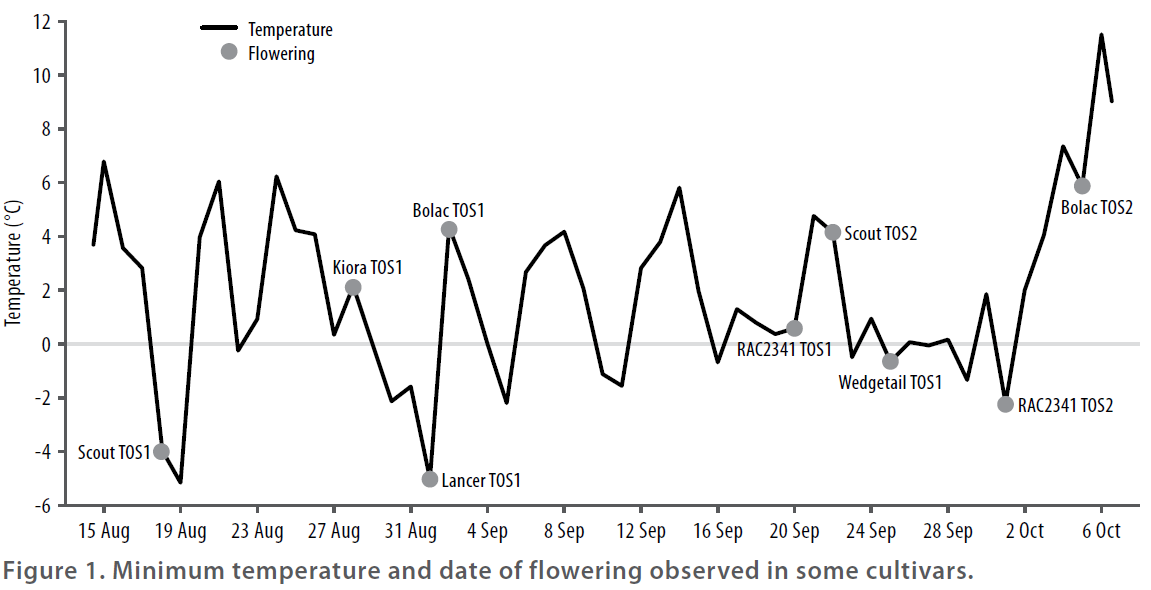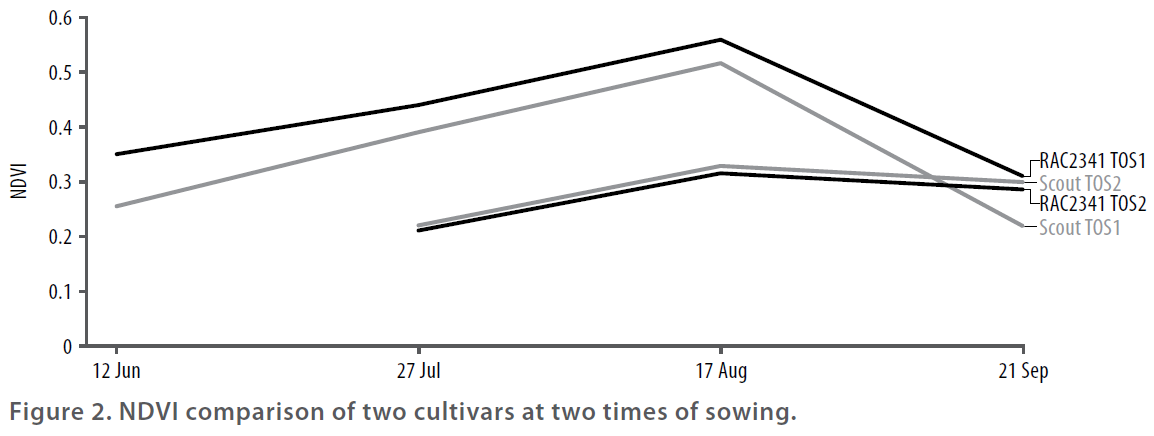Due to the ongoing decline in autumn rainfall and increase in farm size, the widening of wheat sowing windows through early sowing has the potential to significantly increase average farm wheat yield and profitability in years with early establishment opportunities. However, early sowing requires cultivars that are slower to develop than those traditionally grown in the Mallee in order to avoid early flowering and higher frost risk. It may also require different management (ie. lower plant densities to increase harvest index) in order to maximise yield.
BCG research carried out from 2012 to 2014 (see references) consistently found that early-sown winter wheats yielded as well as fast developing spring wheats sown in their optimal window. Winter wheats also offer greater flexibility in grazing, and due to their vernalisation requirement (which slows down development in autumn and early winter), they can still avoid high risk frost windows.
TAKE HOME MESSAGES
- Highest yields in 2015 came from early sown (9 April) spring cultivars (with 8mm of irrigation
for emergence). - Winter wheats Wedgetail and RAC2341, sown 9 April, yielded more than Scout sown in the
normal sowing window (8 May). - Reducing plant density in early sown slow-developing wheats did not influence yield in
either the presence or absence of weeds but did result in greater weed growth.
AIM
To compare the yield performance of several slow-developing winter wheat cultivars (requiring vernalisation) with spring wheat cultivars (photoperiod sensitive) at different plant densities, in the presence or absence of weeds.
TRIAL DETAILS
Location: Berriwillock
Soil type: Sandy clay
Annual rainfall: 241mm
GSR (Apr-Oct): 141mm
Cultivars: See Table 1
Sowing dates: 9 April (TOS1) and 8 May (TOS2)
Seeding equipment: Knife points, press wheels, 30cm row spacing
Target sowing density: 50 and 150 plants/m²
Harvest date: 12 November
Trial average yield: 1.48t/ha (TOS1) and 0.96t/ha (TOS2)
TRIAL INPUTS
Fertiliser:
Granulock Supreme Z @ 50kg/ha at sowing
90kg/ha urea (40kg N/ha) top-dressed (GS30)
Herbicide:
Pre-sowing Sakura® @ 118g/ha (weed free plots only)
In-crop Velocity® @ 500ml/ha + Lontrel Advanced @ 50ml/ha
Fungicides/insecticides: Pests and diseases were controlled to best management practice.
METHOD
A replicated trial was sown using a split plot design with time of sowing as whole plots and treatment as sub plot (Table 1). It was designed as a partial factorial, meaning not all treatments were present at both times of sowing.
At the first time of sowing (9 April), the soil was completely dry and all plots were irrigated with 8mm of water applied to the furrow via drip irrigation. Emergence was further assisted by 14mm of rain on 17-18 April. The TOS2 treatment (8 May) was sown into a moist seed bed and germinated shortly after sowing. TOS2 followed standard practice sowing rates with no weeds present.
Experimental treatments are outlined in Table 1. Targeted plant densities were not quite attained for the higher density (150 plants/m2): actual plant densities were 56 and 109 plants/m2. In the weed treatment plots of Bolac, Lancer and Wedgetail, tame oat seeds (cv. Matika) were broadcast prior to sowing at a target density of 50 plants/m2 to simulate a weed population. An average weed stand of 21 plants/m2 was achieved. In TOS1, the inter-row area was not irrigated, with the result that weeds emerged later than the crop.
Assessments carried out in-season included emergence counts of crop and weeds, flowering date (50 per cent heads flowered) and biomass cuts at three timings on selected treatments. The aim was to determine whether crop development types and density influenced crop biomass production and weed biomass. Harvested grain was analysed for yield and standard quality parameters.
RESULTS AND INTERPRETATION
Although they were not as severe as 2014, temperature data revealed multiple frost events at the site: a total of 37 days recorded temperatures below zero at crop canopy height from the end of tillering onwards. The majority of these frost events occurred prior to crops reaching the highly susceptible development stages (flowering and early grain filling). However, many frosts occurred during flowering in several treatments in the trial (Figure 1).
Although frost scoring was not formally conducted, it was visually assessed. Some cultivars, such as Scout at TOS1, suffered some frost damage (10-15 per cent) but still yielded similarly to the other cultivars. Drought and heat were more damaging than frost in 2015.
IMPACT OF TIME OF SOWING
All cultivars yielded more at TOS1. Those that flowered very early (in August), minimising the effects of moisture and heat stress (Scout, Kiora – Table 2), were the highest yielding. This result is common in drier seasons. However, having crops flower this early (a month before optimal date ~15 September) is risky as it greatly increases the probability of frost damage. Simulating crop development in Yield Prophet® indicated that Scout flowering this early would be subjected to a 100 per cent chance of moderate frost damage (temperature between 0 and -2 degrees).
Highest ‘safe’ yields (that is, treatments that flowered at the optimal time) where frost risk was minimised, came from Wedgetail and RAC2341 sown 9 April (Table 2). Both of these cultivars yielded better than Scout sown on 8 May (0.31 and 0.48t/ha respectively), but flowered at the same time. This result is similar to that of 2014, and suggests that winter wheats are the best option for widening sowing windows.
Further to this, RAC2341 (a new variety being developed by AGT) produced comparable yields to Scout when both were sown on 8 May. This suggests that this ‘fast’ type of winter wheat may offer more flexibility than Wedgetail which is not adapted to late sowing. RAC2341 is still being evaluated. Provided yield, disease and quality performance are acceptable, it will be released in 2018.
Slow developing spring wheats such as Bolac and Lancer flowered too early at the TOS1, and too late at TOS2. Experience suggests these cultivars have a very narrow sowing window which extends from 15-25 April. This greatly reduces their flexibility and suitability for the Mallee, although yields in this trial did not reflect these concerns.
At TOS2, protein was significantly higher due to yield concentration effects and most cultivars had higher screenings, evidence of the effects of the hot and dry finish.
SOWING DENSITY, CULTIVAR AND WEED CCOMPETITION
The presence of weeds reduced yield by 0.1t/ha (P=0.018), but there was no significant effect of plant density or interaction with weeds on grain yield. Weeds reduced yield equally at both densities. However, reducing plant density from 109 plants/m2 to 56 plants/m² increased weed biomass from 0.4 t/ha to 0.7 t/ha, averaged across all cultivars (P=0.005). There is a strong relationship between weed biomass and seed production. This is important in that, even though yield was not significantly reduced at low plant densities in the presence of weeds, weed seed production would be greater. Given this, it is beneficial to have higher plant densities to complete with weeds early as part of an integrated weed management program.
BIOMASS PRODUCTION
Biomass production, as indicated by Normalised Difference Vegetation Index (NDVI), of two cultivars is compared in Figure 2. It helps to explain how early sown treatments can yield more than later sown treatments. Faster biomass production early in the season results in early sown crops covering the ground more quickly and more completely. This, in turn, increases radiation interception, reducing the amount of water lost to evaporation and increasing the amount transpired by plants to produce dry matter.
Greater growth during the cooler months also means early-sown crops transpire more efficiently, converting each millimetre of water used into more dry matter. Both of these factors contribute to higher water use efficiency for dry matter production. Because early- and late-sown crops have the same amount of water to grow, early-sown crops produce more dry matter. Total dry matter production is highly correlated to grain number and thus yield.
A common concern is that early-sown crops will produce excessive dry matter and ‘hay off’. This can occur in some situations, but generally the extra dry matter production compensates for decreased harvest index due to greater early water use. About 30 per cent of this total dry matter can be translocated by wheat into grain. In very dry years such as 2015, there is no stored soil water that can be saved for later use at grain fill.
Greater dry matter production usually results in higher yields, because of the ability to translocate this increased dry matter into grain. This is particularly true in modern no-till farming systems with wider row spacings (eg. 30cm) and lower nitrogen (N) fertility. Also, modern cultivars are much more successful at translocating accumulated dry matter into grain as water soluble carbohydrates.
COMMERCIAL PRACTICE
In most regions of the Mallee, 2015 did not offer the early sowing opportunities investigated in this trial. However, the results highlight the benefits of taking such openings when they arise and using cultivars well-adapted to the Mallee.
It is a challenge to be able to sow the entire planned wheat area on time so that crops flower
during the optimal window. By keeping seed of a slow developing cultivar, and capitalising on these opportunities, growers can spread their risk and their workload. They may also graze early sown crops during the vegetative phase to diversify income sources.
In all cultivars, yields were greatest when sown early, but frost risk needs to be taken into
consideration. Although early-sown Scout achieved the highest yields, it flowered at a high risk time (mid-August). Two years of trials have demonstrated that early sown winter wheats still out-yielded main season sown spring wheats, whilst flowering at a time when frost risk is minimised.
For the second year in a row, Wedgetail proved to be a viable early sowing option in the Mallee. New winter cultivars such as RAC2341 look promising and will offer better early sowing options with a very wide sowing window (March-early May) for growers in the Mallee.
Although there were no yield penalties for lower seeding rates of slow-developing cultivars, growers should keep seeding rates up to allow for greater competition with weeds and therefore reduced weed seed set. This is particularly important in early-sown crops when weed control with knockdown herbicides prior to sowing may not be possible or effective, particularly as brome grass and ryegrass are unlikely to have germinated prior to the onset of cooler temperatures.
ON-FARM PROFITABILITY
Widening the sowing window can offer increased profitability in a number of ways including the opportunity to increase yields through optimising flowering time and setting greater yield potentials (provided well-adapted cultivars are available), as well as diversifying production and therefore profitability through incorporating dual purpose grazing.
Growers can use slower-developing winter wheat cultivars to increase the amount of crop flowering on time. This can result in improvements in yield and profitability and also reduces risk due to frost, drought and heat. It also improves the ability of growers to capitalise on late summer storms or early season breaks when they occur.
To put this into perspective, if a grower who would largely grow Scout (AH classification) as a main season cultivar managed to get a storm a month earlier and took the opportunity to sow a portion of their property to a winter cultivar such as Wedgetail (APW classification) the benefit of this decision in 2015 would have been an additional $48.69/ha based on the yields and quality achieved in the trial (Scout TOS2 achieved AUH2 grade, Wedgetail TOS1 achieved AGP grade).
REFERENCES
McMillan D. and Hunt J., 2012, 2012 BCG Season Research Results, ‘Growing winter wheat on summer rain’, pp 23-26.
McMillan D. and Frischke A., 2013, 2013 BCG Season Research Results, ‘Sowing in February: crazy or clever?’ pp 39-44.
Ick D. and Hunt J., 2014, 2014 BCG Season Research Results, ‘Early sowing of wheat’, pp 65-70.
ACKNOWLEDGEMENTS
This research was funded by the GRDC as part of ‘Increasing yields and reducing risk through early sowing in the southern grain region’ (CSP00178).





